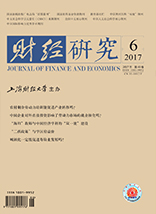已有研究主要基于性别比失衡的竞争性储蓄动机解释了中国家庭的高储蓄之谜。文章把子女结婚这一自然事件作为处理变量,通过婚前和婚后的家庭储蓄变化识别出"婚姻效应",为竞争性储蓄动机理论和中国家庭的高储蓄之谜提供了微观证据。研究结果发现,在控制个人以及家庭特征后,相对于已婚家庭,未婚家庭储蓄显著更高。在排除地区性差异、教育储蓄动机、预防性储蓄动机和样本匹配等问题之后,未婚比已婚家庭具有更高储蓄水平的结论依然稳健。文章进一步分析识别出了城市和农村异质"婚姻效应"和婚后消费结构的变化,发现"婚姻效应"对不同收入水平的家庭都产生了影响,但"婚姻效应"对低收入家庭的消费抑制更为明显。文章的研究结果丰富了婚姻市场的竞争性储蓄动机理论。
为结婚而储蓄?——来自中国家庭追踪调查①(CFPS)的经验证据
摘要
参考文献
7 金烨, 李宏彬, 吴斌珍.收入差距与社会地位寻求:一个高储蓄率的原因[J].经济学(季刊), 2011, (3):887-912.
13 周俊山, 尹银.中国计划生育政策对居民储蓄率的影响——基于省级面板数据的研究[J].金融研究, 2011, (10):61-73. DOI:10.3969/j.issn.1003-1812.2011.10.014
14 Chamon M, Prasad E. Why are saving rates of urban households in China rising[R].IMF Working Paper, 2008.
15 Cole H L, Mailath G J, Postlewaite A. Social norms, savings behavior and growth[J].Journal of Political Economy, 1992, 100(6):1092-1125. DOI:10.1086/261855
16 Deaton A, Paxson C. Saving, growth, and aging in Taiwan[R].NBER Working Paper No.w4330, 1993.
17 Du Q, Wei S-J. A sexually unbalanced model of current account imbalances[R].NBER Working paper No.16000, 2010.
18 Hopkins E, Kornienko T. Running to keep in the same place:Consumer choice as a game of status[J].American Economic Review, 2004, 94(4):1085-1107. DOI:10.1257/0002828042002705
19 Wang X, Wen Y. Housing prices and the high Chinese saving rate puzzle[J].China Economic Review, 2012, 23(2):265-283. DOI:10.1016/j.chieco.2011.11.003
20 Wei S-J. Sex ratio imbalances stimulate savings rates:Evidence from the missing women in China[R].NBER Working Paper, 2008.
21 Wei S J, Zhang X. The competitive saving motive:Evidence from rising sex ratios and savings rates in China[J].Journal of Political Economy, 2011, 119(3):511-564. DOI:10.1086/660887
引用本文
余丽甜, 连洪泉. 为结婚而储蓄?——来自中国家庭追踪调查①(CFPS)的经验证据[J]. 财经研究, 2017, 43(6): 17–27.
导出参考文献,格式为:





 10076
10076  8333
8333

